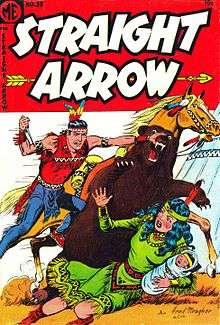Straight Arrow

The Straight Arrow radio program was a western adventure series for juveniles which was broadcast, mostly twice weekly in the United States from 1948 or 1949 through 1951.[1] A total of 292 episodes were aired.[2]
Although first broadcast only in California, in early 1949 it was broadcast nationally on the Mutual Broadcasting Network.[3] All the programs were written by Sheldon Stark.
The protagonist, rancher Steve Adams, became the Comanche Indian, the Straight Arrow, when bad people or other dangers threatened. In fact, Adams was a Comanche orphan who had been adopted by the Adams ranching family and later inherited the ranch. His dual identity was known to only one friend.[4][5] Internal evidence places the ranch in the vicinity of the Colorado Rockies in the 1870s.[6] Howard Culver played both Adams and Straight Arrow.
The program was sponsored by Nabisco Shredded Wheat cereal.[7]
Comic book and comic strip
Like many other children's programs, this one soon had cross-over presence. The Straight Arrow comic book, published by Magazine Enterprises, first came out in February 1950.[8] Most of the stories were written by Gardner Fox.[9] In addition, there was a Straight Arrow comic strip[10] for which Fox wrote all the scripts as well as and Straight Arrow collectible cards of Indian crafts inserted in the boxes of Nabisco Shredded Wheat cereal.[11]
References
- ↑ .
- ↑ French, Jack; Siege, David S. "Straight Arrow" in Radio Rides the Range: A Reference Guide to Western Drama on the Air, 1929–1967. pp. 172–176.
- ↑ .
- ↑ .
- ↑ .
- ↑ French, Jack; Siege, David S. "Straight Arrow" in Radio Rides the Range: A Reference Guide to Western Drama on the Air, 1929–1967. pp. 172–176., pp. 174–175.
- ↑ .
- ↑ .
- ↑ French, Jack; Siege, David S. "Straight Arrow" in Radio Rides the Range: A Reference Guide to Western Drama on the Air, 1929–1967. pp. 172–176., p. 175.
- ↑ .
- ↑ French, Jack; Siege, David S. "Straight Arrow" in Radio Rides the Range: A Reference Guide to Western Drama on the Air, 1929–1967. pp. 172–176., p. 176.